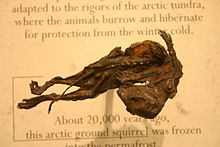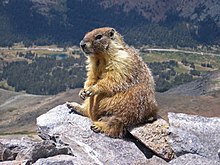Ground squirrel
| Ground squirrel Temporal range: Early Oligocene to recent
| |
|---|---|

| |
| Ground squirrel in Turkey | |
| Scientific classification | |
| Domain: | Eukaryota |
| Kingdom: | Animalia |
| Phylum: | Chordata |
| Class: | Mammalia |
| Order: | Rodentia |
| Family: | Sciuridae |
| Subfamily: | Xerinae |
| Tribe: | Marmotini Pocock, 1923 |
Genera
| |
|
Palaeosciurus (fossil) | |
Ground squirrels are
Together, they make up the "marmot
The chipmunks of the genus Tamias frequently spend time in trees. Also closer to typical squirrels in other aspects, they are occasionally considered a tribe of their own (Tamiini).[3]
Evolution and systematics

Where the Marmotini originated is unclear. The subtribes probably diverged in the early to mid-
Whether the Marmotini dispersed between North America and Eurasia via "
In any case, expansion of the Marmotini to Africa was probably prevented by
Size
Ground squirrels can measure anywhere from about 7.2 inches (18 cm) in height up to nearly 30 inches (76 cm). They can weigh between 0.09 pounds (0.041 kg) and 24 pounds (11 kg).[4]
Habitat
Open areas including rocky outcrops, fields, pastures, and sparsely wooded hillsides comprise their habitat.[5] Ground squirrels also live in grassy areas such as pastures, golf courses, cemeteries, and parks.
Defense mechanisms
Ground squirrels have developed several defense mechanisms to protect themselves from predators. When threatened, they emit high-pitched warning calls to alert others in their colony. This alarm call serves as an early warning system, allowing nearby squirrels to seek cover. The squirrels spend about one-third of their time standing to watch and when a predator is on sight, they stop and watch 60% of the time.[6] Ground squirrels are also known for their burrowing behavior. They have intricate tunnel systems with multiple entrances, which provide escape routes from predators. When a threat approaches, they quickly retreat underground, where they are safe from most predators. Their burrows are designed with multiple chambers and ranges between 5 and 30 feet (1.5 and 9.1 m),[7] making it challenging for predators to reach them. This combination of vocal warnings and burrow construction makes ground squirrels highly adapted to evade danger and survive in the wild.

Diet
Ground squirrels are omnivorous, and not only eat a diet rich in fungi, nuts, fruits, and seeds, but also occasionally eat insects, eggs, and other small animals.[8]
Subtribes and genera

- †Palaeosciurus (fossil)
- Callospermophilus
- Notocitellus
- Otospermophilus (American rock squirrels)
- Poliocitellus(Franklin's ground squirrel)
- Sciurotamias (Chinese rock squirrels)
- Urocitellus
- Xerospermophilus
Subtribe Tamiina: chipmunks (might be full tribe)
- Eutamias
- Neotamias
- †Nototamias (fossil)
- Tamias
Subtribe Marmotina: marmots and prairie dogs
- †Arctomyoides (fossil)
- †Miospermophilus (fossil)
- †Paenemarmota (fossil)
- †Palaearctomys (fossil)
- †Protospermophilus (fossil)
- Marmota
- Cynomys(prairie dogs)
Subtribe Spermophilina: true ground squirrels
- †Spermophilinus (fossil)
- Ammospermophilus
- Ictidomys: Thirteen-lined ground squirrel and related species
- Spermophilus
Cladogram
Below is a partial
| ||||||||||||||||||||||||||||||||||||||||||||||||||||||||||||||||||||||||||||||||||||||||||||||||||||||||||||||||||||||||||||||||||||||||||||||||||||||||||||||||||||||||||||||||||||||||||||||||||||||||||||||||||||||||||||||||||||||||||||||||||||||||||
| ||||||||||||||||||||||||||||||||||||||||||||||||||||||||||||||||||||||||||||||||||||||||||||||||||||||||||||||||||||||||||||||||||||||||||||||||||||||||||||||||||||||||||||||||||||||||||||||||||||||||||||||||||||||||||||||||||||||||||||||||||||||||||
See also
- Tree squirrel
- Xerini—the related "ground squirrels" of Asia and Africa
References
- ^ Kryštufek, B.; B. Vohralík (2013). "Taxonomic revision of the Palaearctic rodents (Rodentia). Part 2. Sciuridae: Urocitellus, Marmota and Sciurotamias". Lynx, N. S. (Praha). 44: 27–138.
- ^ Armitage, K.B.; Blumstein, D.T. (2002). "Body-mass diversity in marmots. Holarctic marmots as a factor of biodiversity". In K.B. Armitage; V.Yu. Rumiantsev (eds.). Holarctic Marmots as a Factor of Biodiversity. ABF Publishing House. pp. 22–32.
- ^ Steppan et al. (2004)
- ^ Karels, Tim (2004). Grzimek's Animal Life Encyclopedia (Vol. 16: Mammals V. 2nd ed.). Gale. p. 143.
- ^ National Audubon Society Field Guide to Mammals
- ISSN 1432-0762.
- ^ "Ground Squirrel / Home and Landscape / UC Statewide IPM Program (UC IPM)". ipm.ucanr.edu. Retrieved 2023-10-25.
- ^ "Squirrels: Diet, Habits & Other Facts".
- ^ Helgen et al. 2009, p. 274.
Further reading
- Helgen, Kristofer M.; Cole, F. Russell; Helgen, Lauren E.; Wilson, Don E. (April 2009). "Generic Revision in the Holarctic Ground Squirrel Genus Spermophilus". Journal of Mammalogy. 90 (2): 270–305. S2CID 28483038.
- Steppan, Scott J.; Storz, B.L. & Hoffmann, R.S. (2004): "Nuclear DNA phylogeny of the squirrels (Mammalia: Rodentia) and the evolution of arboreality from c-myc and RAG1".
- Thorington, R.W. & Hoffmann, R.S. (2005): Family Sciuridae. In: Mammal Species of the World—A Taxonomic and Geographic Reference: 754–818. Johns Hopkins University Press, Baltimore.
